

Although among the smallest members of the solar family, comets hold answers to some of the biggest questions regarding the origin of the solar system. The birth of comets is intimately tied to the birth of the solar system itself. They appear to have formed in the outer solar system as direct condensates from the ancient solar nebula. By virtue of their icy compositions and small sizes, they may have preserved evidence of their conception and birth 4.6 billion years ago. Comets may also have played an important role in the subsequent history of the solar system. Many of the impactors that created the heavily cratered surfaces of the planets and dominated the early history of the solar system from Mercury to the satellites of Neptune were probably comets. When they struck, they may have given each planet some of its volatile constituents. Some say comets may have also implanted organic molecules that were the building blocks of life on Earth. Thus, the ultimate goal of studying a comet is to understand its birth and death and thereby relate it to the formation, evolution, and present state of the solar system.
1. Comets are small bodies composed basically of ice and dust. Their icy nuclei partially vaporize when they come close to the Sun, forming large diffuse comas and spectacular tails of gas and dust.
2. Comets may have formed near Uranus and Neptune by condensation of gas in the ancient solar nebula. Subsequent gravitational perturbations from Jupiter probably ejected them to a distant cloud of comets that presently envelops the solar system--the Oort cloud. Periodically, some comets are gravitationally forced into shorter elliptical orbits that take them into the inner solar system.
3. Several small Sun-orbiting bodies, only recently discovered, along with comets, are remnants of the planetesimals that accreted to form the outer planets and their satellites. Unaffected by the processes of planetary differentiation, comets may tell us about the nature of the solids that condensed in the outer reaches of the ancient solar nebula.
Long regarded as omens of ill luck and catastrophe, comets may ultimately provide us with critical data necessary to explain many mysteries associated with the formation of the planets. Individual comets represent a very small portion of the total mass of the solar system, and most revolve about the Sun at such great distances that they are almost lost from our solar system. As a result, we tend to ignore them, but the recent return of Halley's comet to the inner solar system brought comets back into the spotlight.
Most comets are thought to be concentrated in the Kuiper belt or a loosely defined group called the Oort Cloud in the very outer reaches of the solar system. There is no direct evidence for the existence of the Oort cloud but its presence is inferred from the highly elliptical nature of comet orbits, which take many of them very far from the Sun (Figure 14.1). Moreover, the orbits of comets that have long orbital periods are not confined to the same plane as the planets. Thus, a loose cloud of comets speculated to surround the solar system extends to 200,000 times as far from the Sun as Earth one tenth of the distance to the closest star. Some estimates claim that this reservoir of comets contains as many as 7 trillion comets with a total mass 50 times that of Earth's.
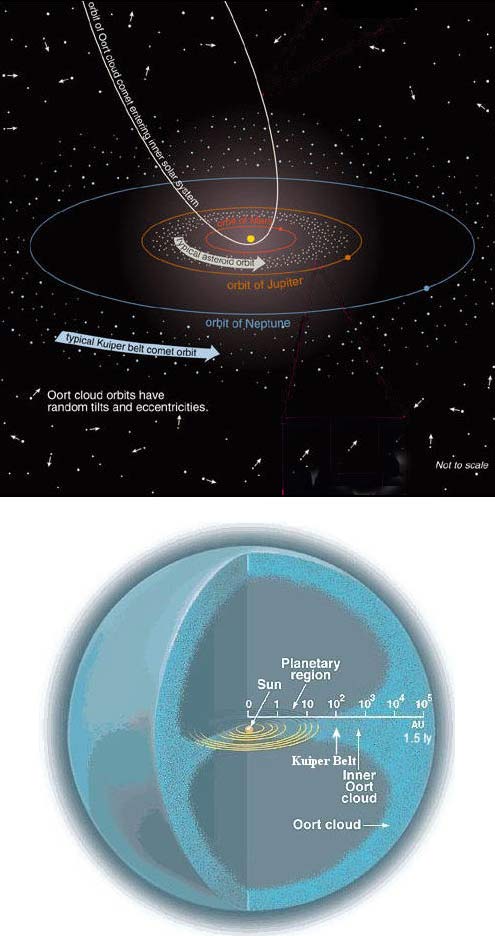
Another speculative group of comets may lie closer to Pluto, in what is called the Kuiper belt. This group may produce comets with short orbital periods that commonly have orbits that lie in the same plane as the rest of the planets. The Kuiper belt may be populated by a remnant of the group of comets ejected to form the Oort cloud. The total number of comets in this Sun-orbiting belt is probably small compared to that estimated for the Oort cloud. There may be fewer than 1000 bodies in this group. Pluto and Charon are considered to be members of the Kuiper Belt.
Because individual comets are so small, they are not visible until they come near the orbit of Mars. Once inside our viewing range, most comets appear as the one in Figure 14.2. The spherical, diffuse region at the front of the comet is called the coma; it may be 100,000 to over 1,000,000 km in diameter. Inside the coma is a small, solid body called the nucleus, which is probably no more than 1 to perhaps 100 km across. Streaming away from the coma, in a direction that is always away from the Sun, is a long bright tail. These magnificent tails may extend for several tens of millions of kilometers. A comet does not develop a coma or tail until it is near the Sun. The coma and tail are produced when ices in the nucleus sublimate or vaporize, carrying dust particles with them, and stream away because of the solar wind.
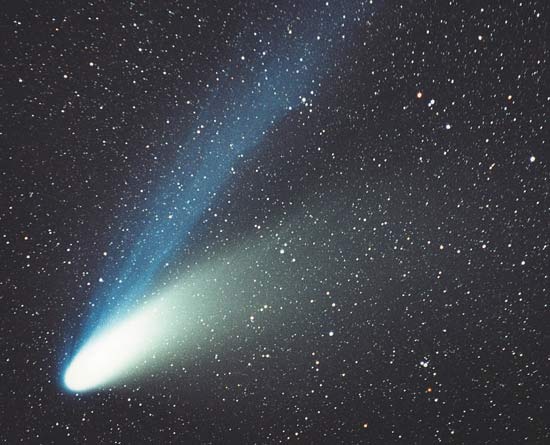
The 1986 passage of Halley's comet through the inner solar system provided an opportunity for five spacecraft to study it, adding to the information gained from ground based studies of comets. The chemical composition of cometary nuclei is critical to understanding the origin of comets and of low temperature nebular condensates. Spectroscopic studies of Halley's comet indicate that the gas and dust cloud consisted of a variety of molecules composed of volatile elements--hydrogen, nitrogen, carbon, and sodium. Eighty percent of the gas consists of water. Significantly for our models of the nature of the outer solar nebula, carbon monoxide ice is present in the nucleus of Halley. Magnesium, iron, silicon, and nickel, probably in dust particles, can be detected when comets come very near the Sun. This is interpreted to mean that the nucleus consists of carbonaceous materials and hydrated silicate minerals mixed in a matrix of water and other ices (carbon monoxide, carbon dioxide, methane, and ammonia). The temperature within the nucleus may be only 25 to 40 K. The spacecraft found many particles similar in composition to primitive carbonaceous chondrites (Chapter 8). About one-third of the coma consisted or organic molecules, some of the same sort identified in these primitive meteorites. Evidence from Halley's comet shows that silicates may exist only as fluffy, dust sized particles, hence, the common description of comets as dirty snowballs.
Although obscured by streams of gas and dust, photographs of Halley's nucleus by the European Space Agency probe Giotto and the Soviet Vega, showed it to be a tumbling irregular dark mass 15 km long and about 7 km wide (Figure 14.3). Estimates of the density of the nucleus range from 0.1 to 0.4 g/cm3. The nucleus is apparently quite fluffy and loosely held together. Most of the comet is empty space, a cosmic sponge cake. Spacecraft photos also showed narrow jets of gas erupting from several areas on the day side of Halley's nucleus. These gas jets appear to form along cracks and allow the gas formed by sublimation of internal ice to erupt. The jets are formed by a process very much like that which forms the geysers on Triton. Halley's jets erupt dust at a rate of as much as 10 tons per second. The ejected material forms the coma and is swept away to form the tail. The comet's nucleus is about as dark as the dark material in the splotch on Saturn's Iapetus. Apparently, when near the Sun, a thick residue of dark carbonaceous and silicate dust is left behind and builds up on the surface of the nucleus as the more volatile ices beneath the crust are vaporized by the Sun's warmth and erupted through the jets (Figure 14.4). The dark dusty lag deposit may thicken and create an armor that coats and protects the icy interior. Nonetheless, Halley loses 1/1000 of its mass every time it enters the inner solar system by these processes.
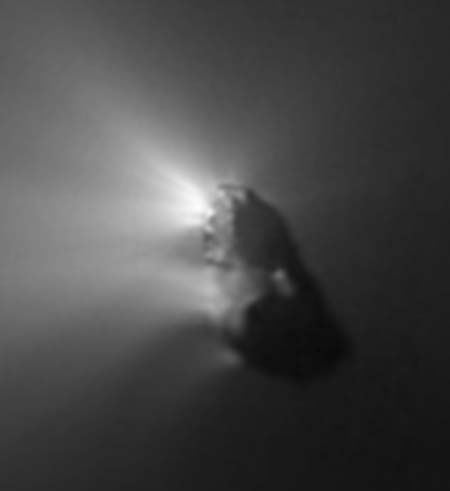
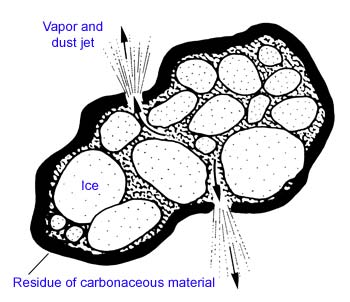
If a comet could be seen when in the portion of its orbit far from the Sun, it would probably look like a dark asteroid. The gases are frozen solid under the surface. There would be no coma or tail in this part of its orbits. The distinction between asteroids and comets is, in fact, fuzzy. Asteroids are bodies that do not degas and develop bright comas, but what happens to a comet nuclei buried in the silicate debris accumulated at its surface after millennia of sublimation? Vaporization of volatiles from the interior might be choked off and the bodies would look like asteroids.

(A) Comet Tempel 1 as photographed by the Deep Impact spacecraft. Shortly after taking the image on the left, the spacecraft crashed into the surface of the comet releasing a spray of vaporized jets that could be studied with telescopes on Earth. The nucleus of Tempel 1 is only about 8 km across.(NASA/JPL/University of Maryland: PIA02142 and PIA02137)
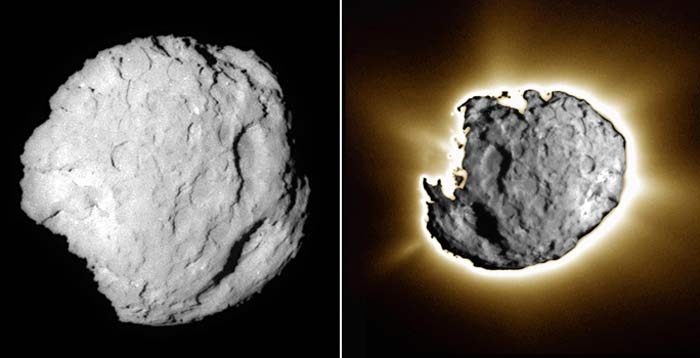
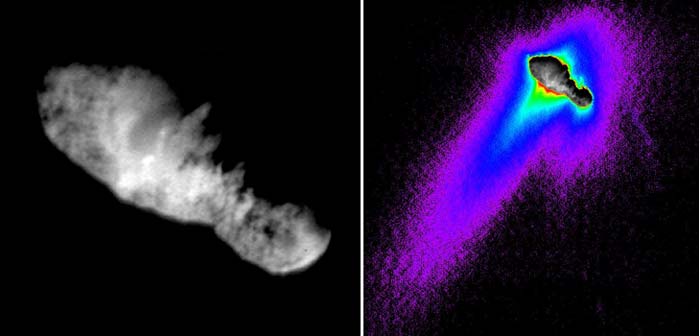
Although not as abundant as the small bodies of the solar system, a growing number of small icy bodies have been discovered in the outer solar system. Increasingly sensitive telescopes have been used to track down these icy equivalents of the asteroids. Several small bodies, besides Pluto and its moons, have been discovered with orbits beyond that of Neptune. Most do not yet have formal names. If they lie within 50 AU, they are usually assigned to the Kuiper belt (1 AU is the distance between Earth and the Sun. Neptune orbits the Sun at about 30 AU.) If they are beyond that they probably belong to a "spherical" assemblage called the Oort cloud.
These discoveries show that the outer solar system is littered with chunks of material left over from the formation of the gas giants, just like the remnants of accretion still found in the inner solar system that we call asteroids. These bodies may have formed in the same part of the ancient solar nebula that many comets are thought to have originated. Moreover, they have many similar characteristics, including ice-rich compositions. Phoebe, one of the outer captured satellites of Saturn, is similar in size and color to Chiron. It joins the ranks of Pluto, Charon, and Triton as representatives of a once much larger population of outer solar system planetesimals. The major differences between these bodies and comets may be that their orbits never bring them near to the warm hearth of the inner solar system. Therefore, they lack comas and tails and are not decreasing in size with each passing orbit.
The orbits of comets and the large content of volatile materials show that they formed in the cool (as low as 20 K) part of the solar nebula. Some planetary scientists have postulated that comets formed as small planetesimals between Uranus and Neptune, or even farther out near Pluto. There is no reason to think that the ancient solar nebula ended at Pluto. Studies of other stars show that nebulas around young stars extend as far as 20 times farther than the Pluto-Sun distance away from the central star. If condensation of solids occurs there, the solids are most likely to contain a large proportion of ice, just like comets in our solar system. Such an extended nebular disk may not form large planets for several reasons. First, the density of the material in the solar nebula probably dropped off with increasing distance from the Sun. There was simply less material from which to assemble planetesimals and planets. Second, because of the long orbital periods in the outer solar system, the time between collisional encounters between planetesimals would be long. Consequently, accretion would be slow.
After an icy body formed near Uranus or Neptune, Jupiter's gravitational energy may have altered its orbit and catapulted it into the distant Oort Cloud, a shell of this cosmic debris left over from planet formation. Later gravitational perturbations, perhaps from other stars, further altered the orbits of some comets, fueling a steady stream of "new" comets with shorter orbital periods that pass through the inner solar system. Anciently, those that entered the inner solar system may have produced some of the impact features we see today on the planets and their satellites. Indeed, it may have been a small comet that exploded over Siberia in 1908, knocking down trees for kilometers but creating no crater. If a short period comet does not collide with a planet or moon, its ices eventually vaporize, scattering its dusty carbonaceous and silicate fractions through the solar system.
The final days of comet Shoemaker-Levy 9 illustrate what must have been the fate of thousands of comets before it (Figure 14.5). This comet was discovered in 1993 shortly after it swept close to Jupiter. There the massive gravitational force of the planet ripped the comet into a series of at least 20 perfectly aligned fragments, strung out like an orbiting string of pearls. The fragmented comet became a satellite of Jupiter, swinging around the planet in a highly eccentric orbit. Each newly formed nucleus was surrounded by a coma and tail of gas and dust, making it difficult to measure the exact size of the icy fragments. The best estimates are that the largest was less than about 3 km in diameter. In the summer of 1994, the jewels on this necklace of comets collided one by one with Jupiter creating a series of spectacular explosions in the hydrogen-rich atmosphere of the giant planet. These explosions were the most powerful series of collisions ever witnessed by humans, the equivalent of several million megatons of TNT (Figure 14.6). Before exploding, the fragments penetrated through the clouds on the night time side of Jupiter. The rapid rotation of the planet quickly brought the sites of impact into view.


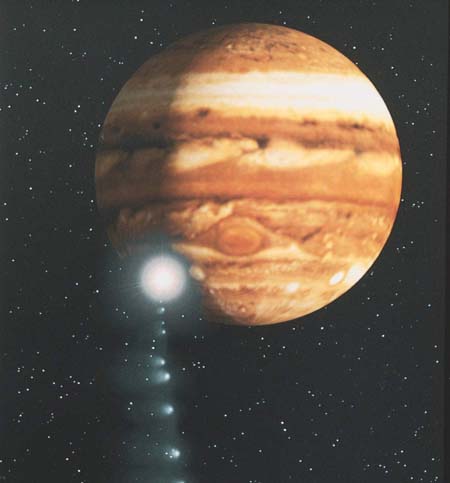
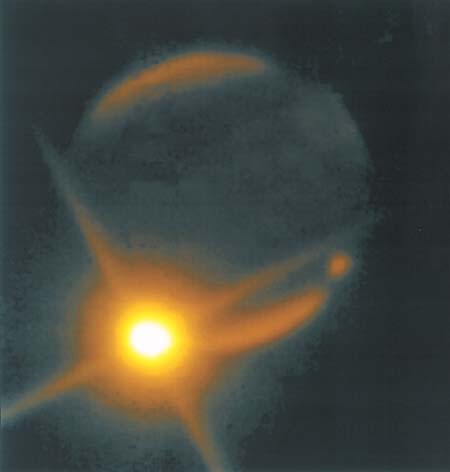
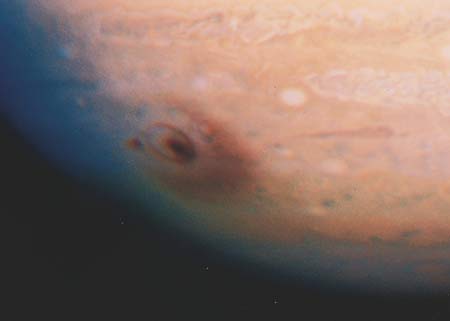
Ultimately, those comets that do not collide directly with a planet, break apart in orbit, because of repeated solar heating. The breakup of these cosmic icebergs is probably caused by heating, gas jetting, and consequent chaotic spinning of the comet nucleus. In effect, the comet becomes "unglued" when its icy matrix vaporizes and jets to the surface. Several comets have been known to fragment, leaving in their wakes streams of particles. Debris from disruption, as well as debris jetted from the comet, eventually strings out along the orbital path of the comet. If this littered path intersects Earth's orbit, meteor showers in the atmosphere of Earth are produced on an annual basis. Examples of comet related meteor showers include the Leonid shower that recurs every November and the Perseid shower in August. The latter is dust and debris shed from comet Swift-Tuttle that reappeared in the inner solar system in 1992; its last visit was during the American Civil War. Some volatile-rich micrometeorites may have reached Earth via comet disruption.
Although there are probably more theories concerning the nature and origin of comets than there are facts, it seems that these small bodies are the remnants of the icy planetesimals that formed the outer planets and their satellites. In this way they are analogous to the rocky asteroids that are the remnants of the planetesimals that formed the inner planets. The cold storage of these icy planetesimals for so long may mean that they preserve some ancient icy materials deep inside them. This is made difficult by the fact that comets have experienced some chemical differentiation since their presumed origin 4.6 billion years ago. Nonetheless, some of the most important geologic information to be gained from comets will be the composition and structure of their nuclei. Studies of these vagabonds of the solar system may help us answer such questions about the nebula as: What were its constituents? How, in what sequence, and at what temperature did ices, silicates, and carbonaceous materials condense? How long ago did condensation occur?
Because of the information that could be gained from comet studies, several additional flyby and perhaps sample return space missions are planned by NASA and the space agencies of other countries for a short period comet with a well established orbit during the next few decades. Since comets are composed of primitive volatile-rich material, such probes with imaging, chemical, and magnetic devices could reveal much more about the physical nature of comets, their structure, and composition, and could yield more pieces to the puzzle that is the early history of the solar system. A sample of this material may be as close as we will ever get to examining the icy condensates of the solar nebula.
Coma (comet)
Kuiper Belt
Nucleus (comet)
Oort Cloud
Solar Wind
Tail (comet)
1. List the principal constituents in comets.
2. In terms of physical characteristics and origin, how is a comet different from an asteroid?
3. Compare and contrast the Kuiper Belt with the Oort Cloud.
3. Describe the probable changes that have occurred in the orbit of a short-period comet that presently passes through the inner solar system.
4. Why do some comets have two tails? Do these tails shows the direction of movement?
5. What is the ultimate fate of comets that enter the inner solar system?
6. What do you think the next investigations of comets should concentrate on? Why?